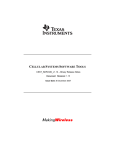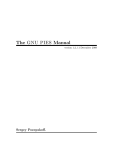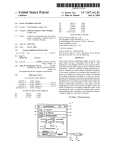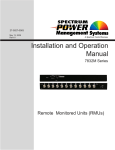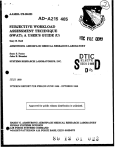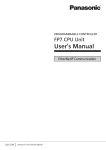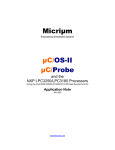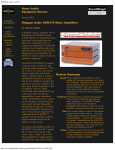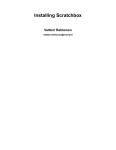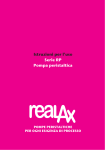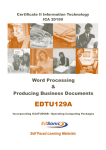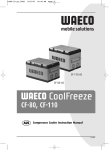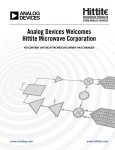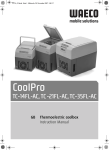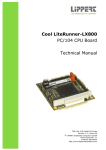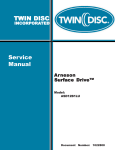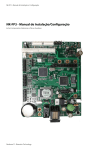Download Embedded Software Components
Transcript
Embedded Software Components 2007 Product Catalog Empowering Embedded Systems 949 Crestview Circle Weston, FL 33327 U.S.A. Tel.: +1 954 217 2036 FAX: +1 954 217 2037 www.micrium.com Empowering Embedded Systems Micrium royalty-free software targets the embedded market Micrium’s vision is to provide the highest-quality embedded software components in industry, in the form of engineer-friendly source code with unsurpassed documentation and customer support. Micrium’s products consistently deliver on that vision to shorten time-to-market throughout all product development cycles. Micrium’s world-renowned real-time operating system, the Micrium μC/OS-II was the first product to embrace this vision. The company’s flagship product, it features the highest-quality source code available for today's embedded market. The industry’s acceptance and praise for μC/OS-II proves that Micrium’s vision and strategy have successfully hit their target within embedded industry. Today, Micrium delivers to the embedded marketplace a full portfolio of embedded software components that complement μC/OS-II. A TCP/IP stack, USB stack, CAN stack, File System (FS), Graphical User Interface (GUI), as well as many other high quality embedded components are now available. The development process at Micrium enforces strict coding standards, code reviews and clear and concise documentation. This process was instrumental in creating a Validation Suite™ for μC/OS-II that provides all documentation necessary to deliver μC/OS-II as a pre-certifiable software component for such safety critical systems as avionics RTCA DO-178B and EUROCAE ED-12B; medical FDA 510(k); and IEC 61058 standard for transportation and nuclear systems. Micrium's μC/OS-II is immediately certifiable for the highest criticality systems, including DO-178B Level A, Class III medical devices, and SIL3/SIL4 IEC-certified systems. Even when products under development are not safety critical, the certifications represent proof points that Micrium's μC/OS-II is the most robust and reliable RTOS available. Micrium believes so strongly in its approach to developing embedded software that the company works very closely with educational institutions to help future embedded software engineers learn the Micrium way. We encourage you to take a look at our catalog to find how the Micrium μC/ product family has expanded over the past few years. Your comments and questions are more than welcome. The μC/Team at Micrium. μC/Probe is a Microsoft Windows application that allows you to display the value (at run-time) of virtually any variable, memory location and I/O port in your product. μC/Probe allows you to display these variables as analog gauges, numeric indicators, thermometers, bar charts, spreadsheets, pie charts, LEDs, and many other visualization methods without requiring you to write any code in your product. No need to use printf() statements, no need to include a user interface in your product, simply include a stub (provided in source form) in your target and you can start looking at the behavior of your embedded system as you are developing your product. You can use μC/Probe to display the values of temperatures, pressures, altitudes, process variables, state variables, timers and counters, computed values, analog inputs and outputs, minimum and maximum values, execution times, stack usage, I/O registers, I/O ports, tables and arrays, plot variables over time and many more. You can display booleans, integers, floats, and ASCII strings. Works with targets that has or doesn’t have an RTOS. ■ VARIABLES CAN BE DISPLAYED AS: ■ ■ ■ ■ ■ ■ ■ ■ ■ ■ USER INPUT ■ ■ ■ ■ ■ ■ ■ ■ Analog gauges (round or square, linear or logarithmic scales) Numeric indicators Thermometers Bar charts Pie charts Plots (multiple variables per plot) Spreadsheets/workbooks LEDs (round, square, any color) Etc. Sliders Knobs Buttons Pick Lists Radio Buttons Checkboxes Edit boxes DISPLAY BITMAPS ■ ■ User ‘icons’ Pictures Works with any compiler/assembler/linker that can generate an ELF file. ■ ■ μC/Probe allows you to create any number of ‘data screens’ where these variables are displayed allowing you to logically group different ‘views’ into your product. FEATURES ■ WORKS WITH ANY PROCESSOR ■ ■ ■ 8-, 16-, 32-, 64-bit or DSP Uses minimal resources Fast data update CAN INTERFACE VIA: ■ ■ ■ J-Link (ARM-based processors) RS-232C TCP/IP PROJECT MANAGEMENT ■ ■ ■ ■ Supports project hierarchy Project auto-save / restore Create data screens in minutes Unlimited number of data screens MICRIUM 2007 Product Catalog 3 FEATURES AND BENEFITS μC/OS-II is a portable, ROMable, scalable, preemptive real-time, deterministic, multitasking kernel for microprocessors, microcontrollers and DSPs. μC/OS-II can manage up to 250 application tasks and provides the following services: Semaphores | Event Flags | Mutual Exclusion Semaphores (to reduce priority inversions) | Message Mailboxes | Message Queues | Task Management | Time Management | Fixed Sized Memory Block Management μC/OS-II comes with ALL the source code. In fact, the source code is 100% portable ANSI C and is probably the cleanest and most consistent code of any RTOS. The internals of μC/OS-II are described in the book MicroC/OS-II, The Real-Time Kernel (ISBN 1-57820-103-9) by Jean J. Labrosse. All services provided by μC/OS-II starts with the prefix ‘OS’. This makes it easier to know that the functions refer to kernel services in your application. Also, the services are neatly grouped by categories: OSTask???() relate to task management functions, OSQ???() relate to message queue management, OSSem???() relate to semaphore management etc. A validation suite has been developed for μC/OS-II and provides all the documentation necessary to prove that μC/OS-II is suitable for Safety Critical Systems common to Aviation and Medical products. Although this feature may not be applicable to your needs, it does prove that μC/OS-II is a very robust RTOS. μC/OS-II is now 99% compliant with the Motor Industry Software Reliability Association (MISRA) C Coding Standards. These standards were created by MISRA to improve the reliability and predictability of C programs in critical automotive systems. A detailed μC/OS-II compliance matrix describing all of MISRA’s 127 C Coding Rules is available from Micrium’s website. μC/OS-II runs on a large number of processor architectures and ports are available (FREE download) from our web site. The vast number of ports should convince you that μC/OS-II is truly very portable and thus will most likely be ported to new processors as they become available. 4 MICRIUM 2007 Product Catalog μC/OS-II can be scaled to only contain the features you need for your application and thus provide a small footprint. Depending on the processor, μC/OS-II can be reduced to as little as 2K bytes of code space and 300 bytes of data space (excluding stacks). The execution time for most of the services provided by μC/OS-II is both constant and deterministic. This means that the execution times do not depend on the number of tasks running in your application. μC/OS-II has been used in hundreds of products from companies all around the world. Many colleges and Universities worldwide are also using μC/OS-II in curriculum teaching the subject of real-time systems. This ensures that engineers in the workplace are trained and ready to use μC/OS-II in your products. You can ‘View’ the status of your tasks which are managed by μC/OS-II with an add-on module called μC/OS-View. To accomplish this, you add a small target resident module that communicates with a Microsoft Windows application via an RS-232C serial port. μC/OS-II KA (Kernel Awareness Plug-In) allows you to display μC/OS-II’s internal data structures in a convenient series of Windows integrated with the C-SPY Debugger within the IAR Embedded Workbench. This provides you with information about each of the active tasks in the target application, about each semaphore, mutex, mailbox, queue and event flag group along with a list of all the tasks waiting on these kernel objects, and more. This can become very useful to the embedded developer when testing and debugging applications. Other debuggers also provide Kernel Awareness for μC/OS-II: Lauterbach, Nohau, iSystem and others. During the standard development process in OSEK/VDX system development, the system architect generates one or more system description files, containing the “OSEK/VDX Implementation Language” (OIL). The OSEK/VDX Extension includes a template based code generation tool, which allows the automatic generation of the necessary target configuration files. The code generation tool is a command line tool, which can be integrated in any build process. ■ THE SYSTEM IS CERTIFIED FOR THE FOLLOWING ENVIRONMENTS: ■ ■ ■ Freescale MPC5554 with Windriver Compiler Freescale S12XE with Cosmic Compiler Other processor / compiler environments on request OSEK / VDX This μC/OS-II extension provides the user with a certified OSEK/VDX application programming interface. The OSEK/VDX Extension supports the OS conformance classes BCC1 and ECC1. The COM conformance classes CCCA and CCCB are provided for internal communication. Fig. 1 : OSEK/VDX Extension Overview Your Application 1 Your Application 2 Your System Generation OSEK/VDX OIL OSEK/VDX API Code Generation μC/OS-II Cfg μC/OS-II μC/OS-II Port OSEK Cfg Scope of μC/OS-II with OSEK/VDX Extension MICRIUM 2007 Product Catalog 5 μC/TCP-IP is a compact, reliable, high performance TCP/IP protocol stack. Built from the ground up with Micrium's renowned quality, scalability and reliability, μC/TCP-IP enables the rapid configuration of required network options to minimize your time to market. FEATURES AND BENEFITS CLEANEST SOURCE CODE μC/TCP-IP provides you with the highest quality source code in the industry. μC/TCP-IP is a clean-room design and is not derived from publicly available Unix stacks, yet still maintains compatibility with the Berkeley 4.4 socket layer interface. As with all Micrium products, μC/TCP-IP is written in ANSI C enabling its usage with a wide array of best-of-class crossdevelopment tools. PORTABLE μC/TCP-IP can be used on 16, 32 and even some 64-bit CPUs. HIGH PERFORMANCE μC/TCP-IP was designed specifically for the demanding requirements of embedded systems. Critical sections were kept to a minimum and selected run-time validations can be disabled to enhance performance. μC/TCP-IP implements zero copy buffer management for highest efficiency. SCALABLE AND ROMABLE μC/TCP-IP allows you to adjust the memory footprint based on your requirements. μC/TCP-IP can be configured to only include only those network modules absolutely required by your system. When a module is not used, it’s not included in the build to save valuable memory space for resource limited embedded systems. DRIVER DEVELOPMENT If your NIC hardware is not found in the previous list , you can develop it yourself or contract Micrium to develop it for you. The Interface Layer documentation provided with the source code gives you all the functions API required to write your NIC driver. Again,following the Micrium documentation to understand how to develop your driver is greatly facilitated by the high quality standards used by Micrium to generate all its documentation. THIRD PARTY CERTIFICATION μC/TCP-IP has been designed from the ground up to be certifiable for use in avionics as well as medical and other safety critical products. Even if your product is NOT safety critical, you should view the certification as proof that μC/TCP-IP is a very robust and highly reliable TCP/IP stack. MISRA C The source code for μC/TCP-IP follows the Motor Industry Software Reliability Association (MISRA) C Coding Standards. RTOS required μC/TCP-IP requires the presence of a Real-Time Operating System (RTOS) or Kernel for task scheduling and mutual exclusion. μC/TCP-IP includes all the source code to interface to the μC/OS-II RTOS, but can easily be used with other RTOSs. 6 MICRIUM 2007 Product Catalog Description Integrated MAC Integrated MAC External Ethernet Controller External Ethernet Controller Integrated MAC Integrated MAC Integrated MAC Integrated MAC External Ethernet Controller External Ethernet Controller Integrated MAC Soft core Ethernet MAC ▲ MEMORY FOOTPRINT ROM Size ADD-ON OPTIONS Compiler optimized for Size Compiler optimized for Speed μC/DHCPc 2.2K 2.5K μC/DNSc 1.9K 1.9K μC/FTPc N/A N/A μC/FTPs 9.5K 9.7K μC/HTTPs 6.3K 6.5K μC/POP3c N/A N/A μC/PPP N/A N/A μC/SMTPc μC/SNTPc N/A 1.5K N/A 1.4K μC/TFTPs 2.5K 2.6K RAM Size Typical Configuration Number of small and larger buffers Number of timers Number of timers Number of ARP cache entries Number of TCP connections Number of sockets ALL OPTIONS ENABLED ALL OPTIONS DISABLED μC/TCP-IP Protocol Layers BSD Sockets UDP TCP ICMP IF ARP OS μC/PPP (Optional) NIC (Ethernet/Serial) μC Options Disabled μC Options Enabled 54.0 54.8 μC/TCP-IP TOTAL 3.7 3.8 2.2 2.3 Add-on Options ARP 5.1 5.3 3.3 3.7 10.8 11.3 7.3 7.8 ICMP 5.7 6.0 3.2 3.3 UDP 2.4 2.5 1.1 1.2 TCP 40.0 45.0 31.7 37.3 μC/DHCPc = 1.2 μC/DNSc = DNSc_MAX_HOSTNAME_SIZE * DNSc_MAX_CACHED_HOSTNAMES μC/TFTPs = sizeof(OS_STK) * TFTP_CFG_TASK_STK_SIZE μC/FTPs = sizeof(OS_STK) * FTP_CFG_TASK_STK_SIZE μC/HTTPs = sizeof(OS_STK) * HTTP_CFG_TASK_STK_SIZE Sockets 18.3 20.0 11.5 12.5 0.6 0.7 0.0 0.0 29.0 30.8 15.8 17.9 115.6 125.4 76.1 85.9 BSD CPU Compiler Compiler Compiler Compiler optimized optimized optimized optimized for Size for Speed for Size for Speed 20 Small (256 bytes) and 20 Large (1536 bytes, one Ethernet frame) 30 20 10 10 10 IF IP IP Description Dynamic Host Configuration Protocol (client) Domain Name System (client) File Transfer Protocol (client) File Transfer Protocol (server) HyperText Transport Protocol (server) Post Office Protocol (client) Simple Mail Transfer Protocol (client) Simple Network Time Protocol (client) Trivial File Transfer Protocol (client) Trivial File Transfer Protocol (server) All values are Kbytes. ▲ Driver Atmel AT91RM9200 Atmel AT91SAM7x256 Cirrus Logic CS8900A DavicomDM9000 Futjitsu MB891403 Freescale MCF5208 Freescale MCF5272 Freescale MCF5275 SMSC 91C111 SMSC 91C115 ST STR912 Xilinx EMAC Protocol μC/DHCPc μC/DNSc μC/FTPc μC/FTPs μC/HTTPs μC/POP3c μC/SMTPc μC/SNTPc μC/TFTPc μC/TFTPs For μC/TCP-IP, we have excluded the NIC, PHY, ISR, & BSP layers since these are NIC & board-specific. μC/DHCPc μC/DNSc μC/TFTPs μC/FTPc μC/HTTPs μC/SNTPc μC/FTPs μC/POP3c μC/SMTPc NETWORK INTERFACE CONTROLLER DRIVERS. μC/TCP-IP currently supports Ethernet and Serial NICs. Additional drivers are added on a regular basis. The following drivers are available from Micrium: The following Application Layer protocols are available from Micrium: The following memory footprints were derived for an ARM7 target in ARM mode using IAR's EWARM V4.20A. Compiler optimization set for maximum optimization for either size or speed as indicated. μC/TCP-IP Options set for either most disabled or all enabled. YOUR APPLICATION ROYALTY FREE μC/TCP-IP is licensed on a per end-product basis and does not require any run-time royalties. ADD-ON OPTIONS Utils + C Library TOTAL Typical Configuration size of (OS_STK) on an ARM TFTP_CFG_TASK_STK_SIZE FTP_CFG_TASK_STK_SIZE HTTP_CFG_TASK_STK_SIZE = = = = 4 1024 512 2048 Visit our website for a detailed RAM size calculation formula. MICRIUM 2007 Product Catalog 7 PRODUCT OVERVIEW μC/USB-Host is a real-time USB Host software stack designed for embedded systems equipped with a USB host, or OTG controller. μC/USB-Host is a full-featured, high performance, small footprint, and Operating System independent USB host software stack. μC/USB-Host includes API, class drivers (Mass Storage, HID and CDC), and framework for developing custom class drivers. The stack can be used with or without an RTOS. ARCHITECTURE ■ High performance ■ ROMable and scalable (to reduce footprint) ■ Works with or without an RTOS (commercial or proprietary) ■ Easy to use API. Minimal USB knowledge required. ■ Royalty-free licensing ■ Outstanding documentation and source code (included) ■ Extensive test cases & test harness to verify the stack integration Application USB Class API HID Custom Drivers CDC Hub SPECIFICATIONS ■ USB 1.1 and USB 2.0 compatible ■ Control, Bulk, Interrupt and Isochronous data transfers ■ OHCI, EHCI, UHCI Compatible ■ ANSI C source code ■ Host class drivers (Hub, Mass Storage, HID, CDC) USB D Host Controller Driver Host Controller Hardware Mass Storage Bulk Device Communication Device Class (CDC) CD-ROM Device Mass Storage Device Class (MSC) μC/USB-Device stack and has been designed to work on any embedded system with a USB client controller. A hardware abstraction layer makes it possible to easily port μC/USB-Device to different USB controllers by simply writing or modifying existing hardware access routines. μC/USB-Device can be used with USB 1.1 or USB 2.0. The stack consists of an embedded side, which is shipped in source-code form. Platform Indepedent Services μC/USB-Host‘s software architecture consists of four logical layers. The upper layer, USB Class API, provides class specific services to the applications. The class layer consists of various class drivers and custom drivers specific to the vendor. The USBD (system software) layer configures the device, loads the matching driver, and provides mechanism for data transfers. The bottom layer consists of a driver that interfaces with the host controller hardware. Platform independent services are used by the entire stack for compatibility across different platforms. μC/USB-Device is a USB Device stack that offers the three following classes: BENEFITS The BULK Device allows the PC to send data to the embedded target, the embedded target to receive this data and reply back to the PC Host. The PC is the USB host, the BULK Device resides in the USB client. A driver for the PC, is typically shipped as an executable (.sys), but it is also available as source code. The Mass Storage Device stack enables you to use your embedded target device as a USB mass storage device. Without the need to develop a kernel mode driver for the host operating system, you can simply plug-in your device and use it just like an ordinary disk drive. Virtually every major operating system on the market supports these device classes out of the box. Simply plug-in your device and use it. There is no extra file system code needed if you only want to access the data on the target from the host side. The host OS already provides several file systems. You have to provide file system program code on the target only if you want to access the data from within the target application itself (see μC/FS). TYPICAL MASS STORAGE DEVICE APPLICATIONS Digital camera USB stick MP3 player DVD player Any target with USB interface: Easy access to configuration and data files DRIVERS μC/USB-Device has a hardware abstraction layer allowing rapid addition of support for new devices. Additional drivers are added on a regular basis. Please consult our website. 8 MICRIUM 2007 Product Catalog Manufacturer Atmel Atmel Atmel Atmel Atmel Cypress OKI NXP NXP NXP Renesas Sharp Sharp Sharp ST Microelectronics Driver AT91RM9200 AT91SAM7A3 AT91SAM7S AT91SAM7X AT91SAM9 SL811HS 69Q62 LPC214X LPC2888 LPC318X M16C M30245 LH79524 LH7A400 LH7A404 STR71X FEATURES AND BENEFITS SPEED The highest possible transfer rate on USB 1.1 (12 Mbit/sec) devices is approximately 1.1 MByte per second. This data rate can indeed be achieved on fast system, such as ARM7 and faster. The Mass Storage Device stack provides support for Full speed (12MBit/sec) and high speed (480MBit/sec) transfer rates. MEMORY REQUIREMENTS ROM RAM Bulk 6 kBytes 1 kBytes (mostly used for buffering). MSD 10 kBytes 1 kBytes (mostly used for buffering). Targets with less RAM can also be used. DEVELOPMENT ENVIRONMENT μC/USB-Device is written in portable ANSI-C and thus, μC/USB-Device can be used with most 8-, 16-, 32- and even 64-bit CPUs or DSPs. A C++ compiler is not required but can be used and thus, can be used in C++ based applications. RTOS SUPPORT μC/USB-BULK can be used with or without a RTOS. START/TEST APPLICATION Micrium provides for the Bulk stack, a simple application that is a modified echo server and can be used to test the stack. The sample application simply receives data bytes (one at a time), increments every byte received and sends it back to the host. MICRIUM 2007 Product Catalog 9 ARCHITECTURE The goal of μC/CAN is to reduce the development effort of a developer wanting to embed CAN. The developer just needs to understand signals, messages and bus configurations. The different abstraction layers can be used independently. μC/CAN can be used with or without RTOS. APPLICATION SIGNAL This layer gives access to logical signals, which are located in one or more CAN messages. Changes of signals can be checked and predefined actions can be executed. MESSAGE The message layer organizes all information necessary for sending and receiving CAN messages. Identifier, data length code (DLC) and data (and the linked signals) are bundled and dedicated to one or more buses. BUS MANAGEMENT μC/CAN can communicate via one ore more CAN buses at the same time. The bus management layer organizes the CAN buses and distributes the messages to the different device drivers. DEVICE DRIVER LAYER The device driver layer buffers CAN messages to be sent and received. All hardware dependencies are capsulated in this layer. Your embedded target can also have multiple, different CAN controllers μC/Modbus is a software module that allows your embedded system to communicate to other devices using the MODBUS protocol. μC/Modbus provides both Master (μC/Modbus-M) and Slave (μC/Modbus-S) capabilities to your product (sold separately). Your embedded system can thus act as a Modbus Slave, Modbus Master or both, concurrently. P PROTOCOLS μC/CAN enables the easy and quick implementation of custom CAN protocols such as CANopen. Consult our web site for the availability of μC/CANopen (Small Sensor Slave). DRIVER μC/Modbus is written in C and is highly portable. μC/Modbus supports both ASCII and RTU protocols and, RS-232C and RS-485. μC/Modbus allows you to read or write integer, floating-point (assuming the Daniels Extensions) and discrete values from/to your target system. FEATURES AND BENEFITS Device drivers are available to support different CAN controllers. Please consult our web site for a current list. YOUR APPLICATION ▲ ▲ μC/CAN is a CAN protocol framework, which enables easy and clean implementation of CAN communication paths. μC/CAN is a source code library optimized for speed, flexibility and size. High portability and clean documentation was focused during development. Application Signal Message μC/CANopen I..II Custom Protocol Bus Management MULTIPLE CHANNELS μC/Modbus allows you to have multiple serial interfaces (channels) on a single target system. Each channel is independently configurable at run-time to be either a Master or a Slave and communicate using Modbus ASCII or RTU. RS-232C OR RS-485 μC/Modbus allows you to have multiple RS-232C or RS-485 ports on the same target. ASCII AND RTU μC/Modbus supports both Modbus ASCII and RTU on an individual channel basis. APPLICATION DATA μC/Modbus allows you to assign just about ANY application variable to any Modbus holding register, input register, coil (discrete output) or input status (discrete input). Read and Write from/to up to 65536 16-bit Integer or Floating-Point Holding Registers. Read from up to 65536 16-bit Integer or Floating-Point Input Registers. Read and Write from/to up to 65536 Coils. Read from up to 65536 Input Status. 10 MICRIUM 2007 Product Catalog DEVELOPMENT ENVIRONMENT μC/Modbus is written in portable ANSI-C and thus, μC/Modbus can be used with most 8-, 16-, 32- and even 64-bit CPUs or DSPs. A C++ compiler is not required but can be used and thus, μC/Modbus can be used in C++ based applications. RTOS SUPPORT μC/Modbus requires the presence of an RTOS but can be adapted to just about any commercial or in-house RTOS. μC/Modbus includes interface code to work with μC/OS-II. SUPPORTED FUNCTION CODES Function MODBUS REGISTERS Device Driver Layer MEMORY REQUIREMENTS The amount of code space required by μC/Modbus depends on which function codes are included and varies between 8 and 20 kBytes. The amount of data space (RAM) depends on the number of Modbus channels. Each channel requires about 1 kBytes. 1 2 3 4 5 6 7 15 16 20 21 Code Description Coil Read Discrete Input Read Holding Register Read Input Register Read Write Single Coil Write Single Holding Register Diagnostic Loopback Write Multiple Coils Write Multiple Holding Registers File Read File Write MICRIUM 2007 Product Catalog 11 μC/Clk μC/Clk is a component that implements a Year 2000 compliant clock/calendar module. The clock/calendar module offers the following features: Allows your application to get the current date and time into a structured data type named CLK_DATE_TIME which contains year, month, day, day of week, hour, minute, seconds and time zone. An increasing number of embedded applications use in-circuit reprogrammable memory chips. The advantage of this technology compared to the old generation of one-time programmable or mask programmed chips is obvious: The application can be reprogrammed at any time, i.e. after assembly of the hardware or even after shipment at customer’s site in case of firmware revision or new features. Allows conversion from and to all types of timestamps and CLK_DATE_TIME, get and set the internal 32-bit running counter using any of the four data types. μC/FL is a software for program updates for embedded applications via serial interface from a PC. μC/FL consists of: Maintains time using a 32-bit running counter, starting at 2000/01/01 00:00:00 GMT. Allows your application to obtain timestamps to mark the occurrence of events. A μC/Clk timestamp is a copy of the internal 32-bit running counter. THREE TIMESTAMPS TYPES ARE SUPPORTED: ■ μC/Clk timestamps, which covers years 2000 to 2135 with one second resolution; ■ UNIX timestamps, which covers years 1970 to 2105 with one second resolution; ■ NTP (Network Time Protocol) timestamps, which covers years 1900 to 2035 with one second resolution; μC/Clk can be used with μC/SNTPc to obtain the current date and time from a Network Time Protocol server. μC/LCD μC/LCD is a component that allows you to interface with character LCD (Liquid Crystal Display) modules which are based on the highly popular HD44780 Dot Matrix LCD Controller & Driver. μC/LCD allows you to: Control LCD modules containing up to 80 characters. Display ASCII characters. Display ASCII strings. Define up to eight symbols based on a 5x7 dot matrix. Display horizontal and vertical bar graphs. ■ A Windows application called μC/FlashLoader and runs on a PC ■ Target resident code (called the bootloader or BTL) which is provided in C source code form An embedded application with a FLASH-type memory for program storage. ■ FEATURES Portable to any CPU and FLASH Interfaces via an RS-232C serial port Configurable Optional password 100 % save & fast: CRC-check implemented Easy to use FILE TYPES AND CONVERSION UPDATER The Updater is an add-on and not part of μC/FL. It has been designed to give the end user the possibility of an easy firmware update without using μC/FlashLoader. It is shipped as source code, which requires to modified and thus recompile the Updater. After the Updater is started it shows a dialog which gives the user the possibility to set up the PC COM port. After the Updater tool gets contact with the target, it shows a notification message in the application window. Now the user should only press the Start button or the Enter key to update the target. The tool will clear the flash, programs the new file into the flash, makes a CRC check and makes the target application valid. Intel HEX (*.HEX) Motorola S (*.MOT, S7, S8 and S9) μC/FlashLoader analyses, loads and displays the contents of a file. Files can be relocated and converted. μC/FlashLoader is a 32-bit Windows application and can be started from the Windows Explorer or from the command line. μC/FlashLoader is very easy to use, any hex file (Intel Hex, Motorola S-records, etc.) can be loaded and transferred to the bootloader (BTL) to update your embedded target. The following is a "screen shot" of the Windows application with a loaded hex file and programming a target chip: 12 MICRIUM 2007 Product Catalog MICRIUM 2007 Product Catalog 13 FEATURES AND BENEFITS WIDGETS Widgets are windows with object type properties: buttons, radio buttons, scroll bars, check boxes, list boxes and more. Widgets are called controls in the Windows world. DIALOGS Dialogs are normally windows that appear in order to request input from the user. It may contain multiple widgets, requesting information from the user through various selections, or it may take the form of a message box which simply provides information (such as a note or warning to the user) and an "OK" button. μC/GUI is a universal graphical software for embedded applications. It is designed to provide an efficient, processor and LCD-controller independent graphical user interface to any application using a graphical LCD. It works in single as well as in multi-task environments. μC/GUI can be adapted to just about any size of physical or virtual display with a LCD controller and CPU. μC/GUI comes with ALL the source code. In fact, the source code is probably the cleanest and most consistent code of any Embedded Graphical User Interface. All services provided by μC/GUI starts with a prefix related to the module to which its belongs to (e.g.: 'GUI', 'WM' ). This makes it easier to know that the functions refer to GUI services in your application. Also, the services are neatly grouped by categories: GUI_Disp???() for 2DGraphics, GUI_AA_???() for Antialiasing, etc. μC/GUI works with just about all CPUs and unlike other GUIs which requires a C++ compiler, μC/GUI is written in 100% ANSI-C. Processors from 8 to 32 bits will run μC/GUI; 16-bit CPUs or better are advisable for performance considerations. JPEG display in a simulation of a target system using a bitmap image of the actual target hardware. GIF and animated GIF is also supported. μC/GUIView, a separate program shows the contents of the simulated LCD even during debugging. Small systems (no window manager) ■ RAM: 100 bytes ■ Stack: 500 bytes ■ ROM: 10-25 kb (depending on the functionality used) ■ TOUCH SCREEN Touch screen support which is now included in the basic package contains a low level driver that handles the analog input (from two 8 bit or better A/D converter channels), debouncing and calibration of the touch screen. This module is optional because you don't have to include it in your product if you don't have a touch screen. VIRTUAL SCREEN A virtual screen means a display area greater than the physical size of the display. It requires additional video memory and allows instantaneous switching between different screens even on slow CPUs. The memory requirements vary depending on which parts of the software are used and how efficient your target compiler is. It is therefore not possible to specify precise values, but the following apply to typical systems. Big systems (including window manager and widgets) RAM: 2-6 kb (depending on number of windows required) ■ Stack: 1200 bytes ■ ROM: 30-60 kb (depending on the functionality used) Widgets and dialogs are operated via a pointing device or keyboard (any key input). MULTIPLE DISPLAYS/LAYERS Windows can be placed in any layer or display and drawing operations can be used on any layer or display. Multiple layers or multiple displays are handled the same way (Using the same API routines) and are simply referred to as multiple layers, even if the particular embedded system uses multiple displays. The μC/GUI viewer allows you to look at every individual layer (display), but in the case of multiple layer systems also to look at the actual output (the composite view). SMALL FOOTPRINT Note that ROM requirements will increase if your application uses many fonts. All values are rough estimates and cannot be guaranteed. SAMPLES μC/GUI is delivered as source code. μC/GUI Bitmap converter. The bitmap converter is intended as a tool to convert bitmaps from a PC format to a C file. The bitmap converter displays the converted image. A number of simple functions can be performed with the bitmap converter, including flipping the bitmap horizontally or vertically, rotating it, and inverting the bitmap indices or colors. Multiple samples of source code are included with the μC/GUI package. Samples are providing a simple introduction to some of the μC/GUI features. For example: ■ ■ ■ ■ ■ ■ ■ 2D Graphics Antialiasing Color Management Windows/Widgets/Dialogs Fonts Memory devices (Anti-flickering) Simulation of hardkeys with th PC simulation environment VNC VNC stands for ’Virtual Network Computing’. It is, in essence, a client server system based on a simple display protocol which allows the user to view a computing 'desktop' environment not only on the machine where it is running, but from anywhere on the Internet and from a wide variety of machine architectures.. LCD DRIVERS Micrium provides driver for the most popular display controllers. ADD-ON OPTIONS Optional add-on modules allow you to customize the memory footprint required and features required by your application. The modules are: MEMORY DEVICES Used to prevent the display from flickering when using drawing operations of overlapping items. ANTIALIASING Smoothes curves and diagonal lines by "blending" the background color with that of the foreground. WINDOW MANAGER Allows you to create and handle different Windows of any size. PC TOOLS μC/GUI comes with a suite of development tools to facilitate your project development. μC/GUI includes a simulation environment under MSVC++. It can be used to write and test the entire user-interface on the PC (all routines are 100% identical to your embedded application, no matter what CPU or LCD you are using). This makes debugging and development easy and convenient. Generating screen-shots of the LCD is a snap. These screenshots can then be inserted into documentation. PC TOOLS μC/GUI Font converter. With the font converter and editor you can convert any font available on your Windows-PC into a “C”-file which can be compiled and linked with your application. This way the font can be displayed on your LCD using μC/GUI . Proportional fonts are supported; fonts for foreign languages can be created the same way. SMA LL FOOTPRINT This is an example combining a large portion of μC/GUI features. USER MANUAL μC/GUI source code is structured and well documented. In addition to the software quality of the source code, the μC/GUI user manual contains over 800 pages describing all the functions API. MICRIUM 2007 Product Catalog 15 μC/FS is a FAT file system which can be used on any media, for which you can provide basic hardware access functions. μC/FS is a high performance library that has been optimized for speed, versatility and memory footprint. μC/FS has been designed to cooperate with any kind of hardware. To use a specific hardware with μC/FS, a device driver for that hardware is required. The device driver consists of basic I/O functions for accessing the hardware and a global table, which holds pointers to these functions. FEATURES AND BENEFITS MEMORY FOOTPRINT These numbers have been achieved using an ARM 7 target in ARM mode with the IAR compiler. The configuration does allow only 1 open file. Additional open files require 1064 RAM bytes (2 sector buffers + one file handle). Using a Ramdisk ROM: 15896 RAM: 1584 LAYERED ARCHITECTURE μC/FS is written in ANSI C and can be used on virtually any CPU. Some of the features of μC/FS are: API Layer <stdio.h> like functions FS_FOpen, FS_FRead, FS_FWrite. MS-DOS/MS-Windows compatible FAT12, FAT16 and FAT32 support or Micrium “FAT-free” proprietary File System. File System Layer Translation of file operations to sector operations. Multiple device driver support. You can use different device drivers with μC/FS, which allows you to access different types of hardware with the file system at the same time. Logical Block Layer Synchronization of device operations for different file operations. Multiple media support. A device driver allows you to access different medias at the same time. Device Driver Low level routines to access sectors of a device and check status. OS support. μC/FS is suitable for usage with just about any multithreaded environment. To ensure that different tasks can access the file system concurrently, you have to implement a few operating system dependent functions. μC/OS-II functions are included with μC/FS. Hardware Layer Low level routines to access your hardware. ANSI C stdio.h like API for user applications. An application using standard C I/O library can easily be ported to use μC/FS. Very simple device driver structure. μC/FS device drivers need only very basic functions for reading and writing blocks. Therefore it is very simple to support your custom hardware. Generic device drivers for: NOR Flash | NAND Flash | SMC (SmartCards) | SD (Secure Digital) | MMC (MultiMedia Card) | CF (CompactFlash) | IDE (Integrated Device Electronics) | Serial DataFlash | RAMdisk | Windows (to allow you to simulate your software in a Windows environment) | Others. MEMORY FOOTPRINT 16 MICRIUM 2007 Product Catalog API LAYER The API layer is the interface between μC/FS and the user application. It contains a library of ANSI C oriented file functions, such as FS_FOpen(), FS_FWrite() etc. The API layer transfers these calls to the file system layer. Currently we only provide a FAT file system layer for μC/FS, but the API layer can deal with different file system layers at the same time. So it is possible to use FAT and any other file system concurrently with μC/FS. Micrium is a worldwide authorized distributor of IAR Systems products. IAR provides a range of development tools for embedded systems: integrated development environments (IDE) with C/C++ compilers and debuggers, development kits, hardware debug probes and state machine tools. IAR KICKSTART KIT™ Whether you are eager to get started or want to evaluate a combination of tools, IAR KickStart Kit includes everything you need to get going quickly–both hardware and software. The kit contains a development board, the IAR J-LINK JTAG debugger with a USB connector,and a suite of software development tools including visualSTATE and an IAR Embedded Workbench project with full μC/OSII source code and on some KickStarts, μC/TCP-IP source code. IAR EMBEDDED WORKBENCH® IAR Embedded Workbench is the most complete suite of professional development tools for embedded applications available today. It offers the same intuitive user interface regardless of the microprocessor you have chosen to work with. Ready-made project templates and configuration files give you a flying start. IAR Embedded Workbench incorporates the IAR C/C++ Compiler, assembler, linker, librarian, text editor, project manager and C-SPY debugger into one integrated development environment (IDE). This gives you an uninterrupted workflow and a single tool suite where all the components integrate seamlessly. Within IAR Embedded Workbench, you can manage projects, create source files, build applications and run them in the C-SPY simulator or on hardware. A Kernel Awareness plug-in allows you to view and interact with information from μC/OS-II in dedicated windows within the IAR Embedded Workbench IDE. Optimizing C and C++ Compilers IAR Systems has developed more compilers for embedded microprocessors than anyone else! The IAR C/C++ Compiler is available for many different architectures ranging from 8-bit MCUs like Atmel AVR, 8051 cores and NEC 78K0, to 16-bit MCUs like TI MSP430, Renesas M16C and Freescale S12, up to 32-bit architectures like ARM, NEC V850 and Atmel AVR32. Every C/C++ compiler contains both generic global optimizations as well as low-level chip-specific optimizations that ensure a small code size while taking advantage of all the specific features of your selected device. IAR J-TRACE AND IAR J-LINK IAR J-Trace and IAR J-Link are small ARM hardware debug devices that connect via USB to the PC host running Windows.They integrate seamlessly into IAR Embedded Workbench for ARM and are fully plug-and-play compatible. FILE SYSTEM LAYER This layer translates file operations to logical block operations. After such a translation, the file system calls the logical block layer and specifies the corresponding device driver for a device. LOGICAL BLOCK LAYER The main purpose of the logical block layer is to synchronize accesses to a device driver and to have an easy interface for the file system layer. The logical block layer calls a device driver to make a block operation. DEVICE DRIVER LAYER Device Drivers are low level routines that are used to access your hardware. The structure of the device driver is simple to allow easy integration of your hardware. MICRIUM 2007 Product Catalog 17 Distributors ASIA CHINA BMR Beijing office (Headquarter) D403, JinYuJiaHua Building, No.9 3rd Street, Shangdi Haidian District, Beijing, China Tel.: +86-10-62975900 Fax: +86-10-62975227 General Manager: Allan He [email protected] [email protected] www.bmrtech.com Shanghai office Room A,23/F, North Tower, Yin Tong Building, Ding Xi Road, Shanghai, China 200050 There are several choices for embedded software components; only one makes sense. At Micrium, ease-of-use is a commitment that guides all product development. Micrium has a solid reputation for delivering clean, Royalty-Free source code, unsurpassed documentation and support for the embedded systems designer. Our full suite of embedded components includes: ■ ■ ■ ■ ■ ■ ■ RTOS TCP/IP Stack USB Stack File System Graphical User Interface (GUI) CAN Stack Modbus Stack Tel.: 8621-62127690 Fax: 8621-62128032 Manager: Yin Lijie [email protected] Shenzhen office 30F, A tower, Caihong Bldg. Caitian Rd., Futian District Shenzhen, China 518033 Tel.: +86-755-82971846/56 Fax: +86-755-82913344 Manager: Liang Changjing [email protected] Embest Shenzhen office Room 509, Luohu Science & Technology Building #85 Taining Road Shenzhen, Guangdong China 518020 JAPAN AUSTRALIA TechnoLogic 5F DAIICHI Bldg.1-3-18, Namba-naka Naniwa-ku Osaka City 556-0011, Japan AUSTRALIA Tel.: +81-6-4397-6620 Fax: +81-6-4397-6630 www.t-logic.jp Mr. Masayuki Wada [email protected] PHILIPPINES, MALAYSIA, SINGAPORE Testech Electronics Pte Ltd Block 118, Aljunied Ave 2, #05-110, Singapore 380118 Tel.: (+65)-67492162 Fax: (+65)-67494246 Mr. Kevin Quek www.testech-elect.com [email protected] SOUTH KOREA Dioiz 7th Floor Acorn Place 757-3 Neson dong, Uiwang Kyonggido 437-081 South Korea Tel.: +82 2 785 5709 Fax: +82 2 2653 0433 Mr. Won Ho Sung www.DIOIZ.com [email protected] TAIWAN Micetek International Inc. 8th Floor, 184, Sec. 1 Chung-Cheng Road, Taipei 111, Taiwan, R.O.C. Tel.: 886-2-28386826 Fax: 886-2-28386827 Mr. Mos Lin www.Micetek.com [email protected] Tel.: +86-755-25636285 Fax: +86-755-25616057 Manager: Zhang Guorui [email protected] www.embedinfo.com [email protected] THAILAND INDIA ISRAEL Accelerated Systems Private Limited 627, 1st Floor, 11th Main H.A.L 2nd Stage Bangalore 560 008 Karnataka, India. Agam Cross Systems Ltd. Atidim, POB 58019 Tel-Aviv 61580, Israel Tel.: 91 - 80 - 5271375, 91 - 80 - 5201917, 91 - 80 - 5201948 Fax: 91-80-5201748 Ms. Soma Pande www.acceleratedsys.com [email protected] INDONESIA Testech Electronics Pte Ltd (See Singapore) Testech Electronics Pte Ltd (See Singapore) MIDDLE EAST Mr. Gil Glazer [email protected] Tel.: +972-3-648-4121 Fax: +972-3-647-8365 US fax: +1-815-371-4803 www.AgamSys.com [email protected] Device Tools Tel.: (+972) 52-2996955 Fax: (+972) 9-7712095 www.devicetools.com www.devicetools.com/company/ [email protected] Macrodynamics Pty., Ltd. "The Embedded Specialists" 322 Mountain Hwy. Wantirna, Suite 7, Victoria, 3152 Tel.: +61 3 9720 2399 Fax: +61 3 9720 2486 www.macrodynamics.com.au [email protected] NEW ZEALAND IAR Systems Software, Inc. 2 Mount Royal Marlborough, MA 01752 USA Tel.: +1 508 485 2692 Fax: +1 508 485 9126 www.IAR.com [email protected] Microcross, Inc. 151 Osigian Blvd., Suite 154 Warner Robins, GA 31088 USA Macrodynamics Pty., Ltd. "The Embedded Specialists" (See Australia) Tel.: 478.953.1907 Fax: 478.953.7661 www.microcross.com [email protected] NORTH AMERICA EUROPE CANADA AUSTRIA Micrium 80 Berlioz, Suite 1108 Verdun (Québec) H3E 1N9 Canada Embedded Office (See Germany) Tel.: +1 514 768 8108 Fax: +1 954 217 2037 www.Micrium.com [email protected] Inside Technology Nordic ApS P.O. Box 4075 DK-8260 Viby J Denmark JORAL Technologies 2448 Fairmile Road Kemptville(Ontario) K0G 1J0 Canada DENMARK Tel.: [+45] 87 34 11 00 Fax: [+45] 87 34 11 20 www.insidetech.dk [email protected] Tel.: 613-258-9683 Direct Line: 613-851-2155 Toll Free: 1-800-GO-JORAL Fax: 613-822-5137 [email protected] FINLAND USA NeoMore ZA Ste Apolline 2 3 rue des Poiriers 78370 PLAISIR, France CORPORATE OFFICES Micrium 949 Crestview Circle Weston, FL 33327 USA Tel.: +1 954 217 2036 Fax: +1 954 217 2037 www.Micrium.com [email protected] Device Tools Tel.: 1-888-866-5338 Fax: 1-888-866-5339 [email protected] www.devicetools.com/company/ www.devicetools.com IAR Systems Software, Inc 1065 E. Hillsdale Blvd Foster City, CA 94404 USA Tel.: +1 650 287 4250 Fax: +1 650 287 4253 www.IAR.com [email protected] Inside Technology Nordic ApS (See Sweden) FRANCE ITALY iSYSTEM S.r.l. Centro Direzionale "Le Torri" Via Marsala, 34/A 21013 Gallarate, (VA), Italy Tel.: +39 0331 775 119 Fax: +39 0331 775 526 Mr. Luca Foglia [email protected] Inside Technology Nordic ApS (See Denmark) SWEDEN Inside Technology Nordic ApS P.O. Box 273 SE-55114 Jonkoping Sweden Tel: [+46] (0) 36 340715 Fax: [+46] (0) 36 340716 www.insidetech.se [email protected] IAR Systems AB P.O. Box 23051 SE-750 23 Uppsala, Sweden Tel.: +46 18 16 78 00 Fax: +46 18 16 78 38 [email protected] Combitech Systems AB Slottsgatan 15 553 22 Jonkoping, Sweden Tel.: +46 36 194611 Fax: +46 36 194361 Mr. Carl Andersson carl.andersson@combitech systems.com SWITZERLAND Embedded Office (See Germany) Tel.: +33 (0) 1 30 64 15 81 FAX: +33 (0) 1 30 64 08 83 Mr. Jean-Luc Trassard [email protected] www.neomore.com THE NETHERLANDS GERMANY Tel.: +31 (0)594 591001 Fax: +31 (0)594 591165 Mr. Jeroen Verheul [email protected] Embedded Office Amann & Hillmann GbR Sigmannser Weg 1 88239 Wangen, Germany Tel.: +49 (07522) 909628 Fax: +49 (07522) 909629 Mr. Thomas Amann [email protected] Mr. Michael Hillmann [email protected] www.embedded-office.de I2 Controls Buitensingel 6 9883 SH Oldehove The Netherlands UK Device Tools UK: 0808-234-8535 Fax: 0808-234-8536 [email protected] www.devicetools.com/company/ www.devicetools.com











